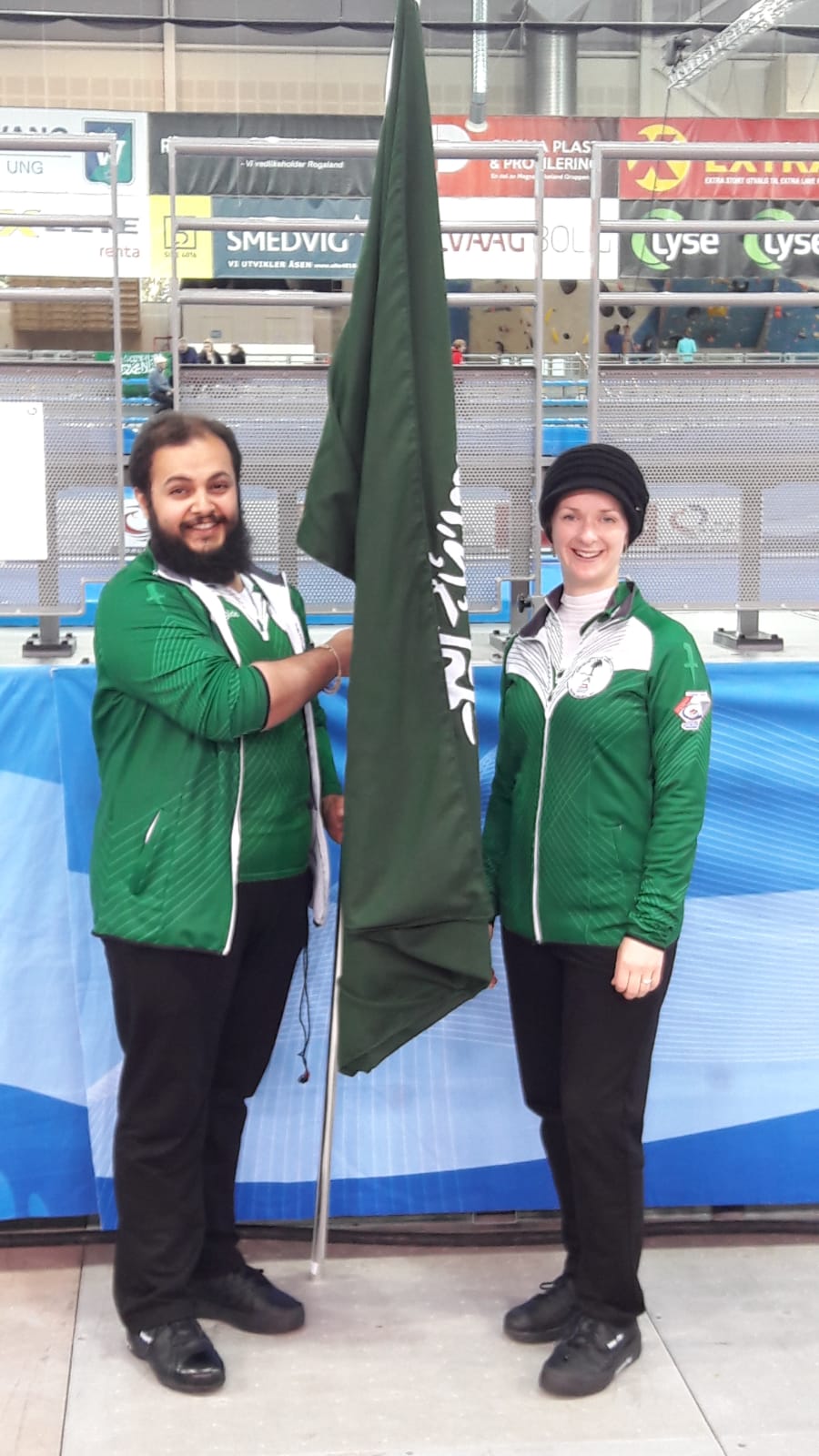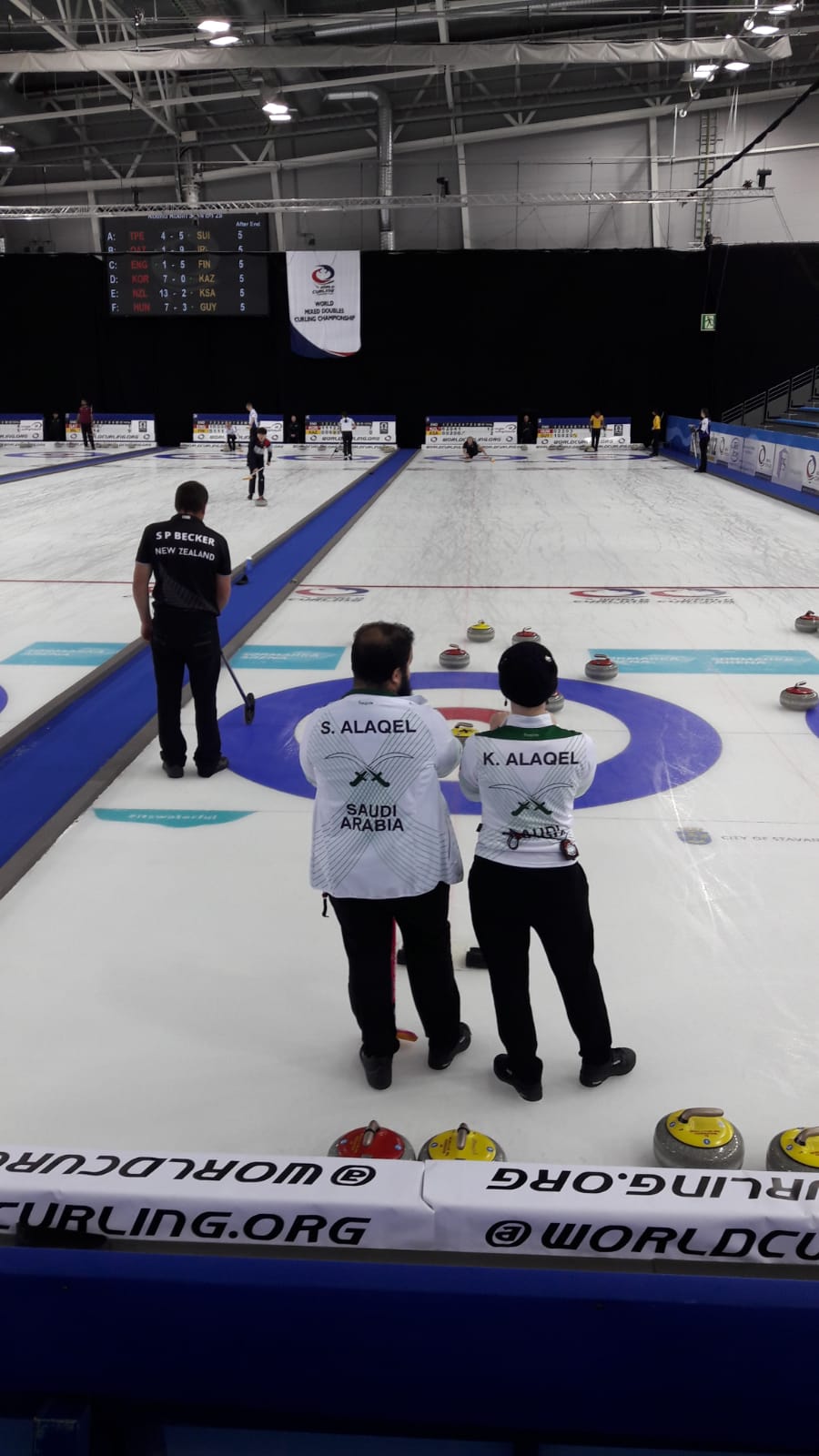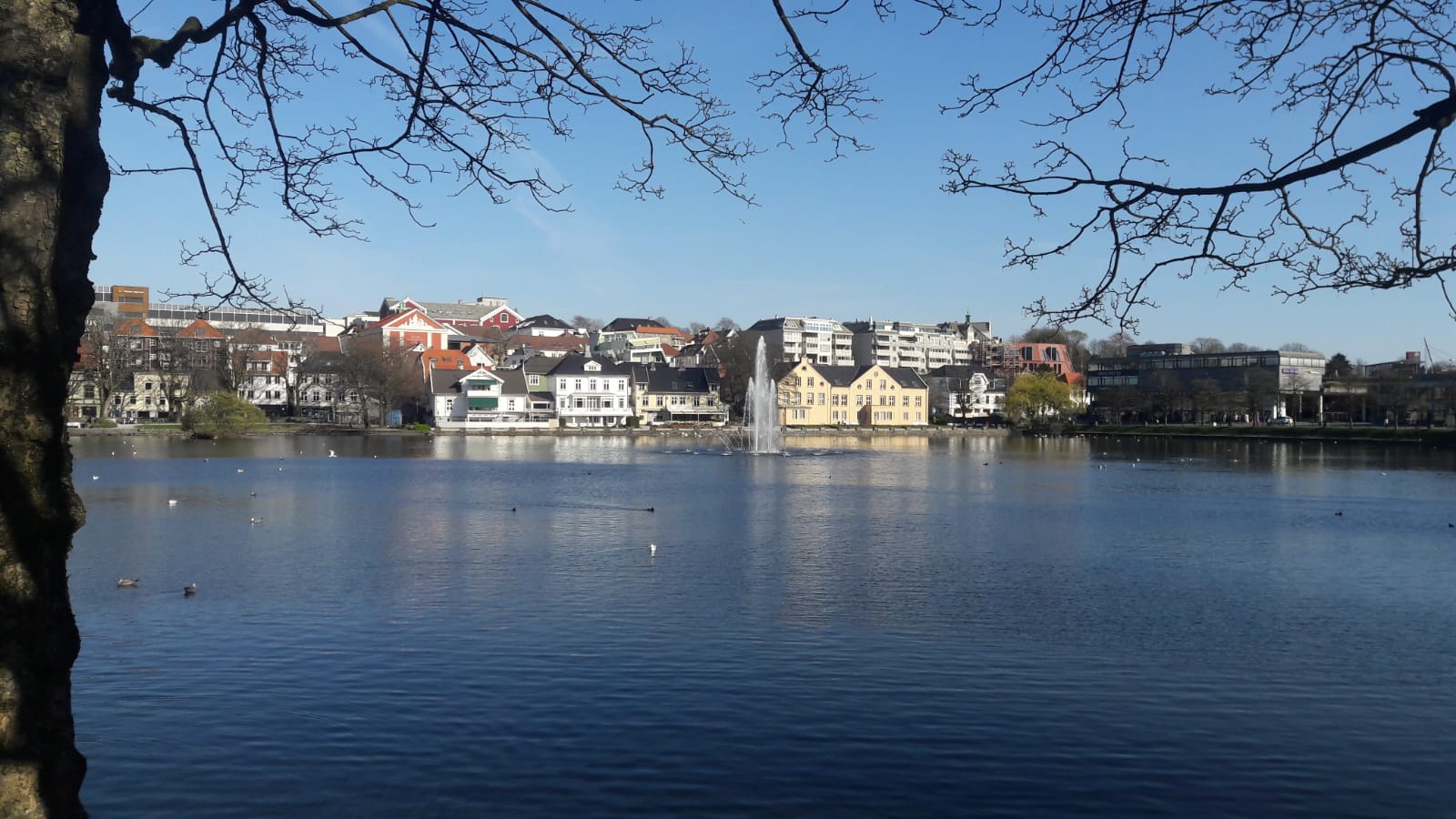International curling
Having shared our development and business plans with them, we keep the Saudi Arabian Olympic Committee (SAOC) up to date with our activities and aspirations. So, we advised them last November that we planned to enter a team for the WMDCC and then asked our curlers if any were interested in forming teams to represent KSA at the competition. The criteria we set was compliant with the WCF rules, athletes with Saudi nationality or residency. Four people came forward, two teams both comprising of one male and one female, as required for mixed doubles. One team consisted of a Saudi curler and his USA-born wife, and the other two were KSA residents, one UK born and a Saudi-born lady of Djibouti descent. The plan was for both the teams, all four of whom had registered for the Zbrsalav camp, to spend the third day there practicing MD theory and tactics, and then finish off with a straight play-off match to determine who would represent the Kingdom. As Robert Burns wrote, “the best laid schemes o’ mice an’ men gang aft a-gley” (plans will go wrong). So in mid-February when we were invited to the SAOC to meet the Prince in charge of sport to brief him on our progress, he ruled that only Saudi citizens could represent the country at full international level. Therefore, the team of residents (the Djibouti descent lady does not have Saudi citizenship even though she was born here) were eliminated from the running. At Zbraslav, the remaining team received their MDs training, and finished off the camp by playing against a team comprising of one of the trainers (Dani) and his lady friend, who themselves had entered the Czech MDs playdowns, but did not qualify. They proved a very difficult challenge to our Suleiman and Karrie Alaqel. The other ruling from the Prince was that the SAOC had to give permission for the team to compete, due to them first having to satisfy some unspecified internal bureaucratic Saudi requirements. This decision making took a long time to be made, and it was only 10 days before the competition started that we were given the green light to attend and compete.
We had made provisional hotel bookings, but were too late to book at the main event hotel in Stavanger, Norway. There was then a scramble to book flights, and of course all the good value tickets were long gone. So on 17th April, four of us left Riyadh, Suleiman and Karrie as athletes, Elaine as team manager/logistics supervisor and myself as team coach. We arrived in Stavanger at midday on the Thursday, checked into the hotel and then took a reconnaissance run to the ice rink and the hotel where the official functions were to be held.
The event ice was at the Sørmarka Arena, a huge indoor area that normally hosts a speed-skating track. In the centre were two ice rinks laid back to back, one for the WMDCC and the other for the World Seniors Championships which were being held simultaneously. This was to be the largest indoor international curling tournament ever held, with 48 MDs teams and 43 Mens or Womens Seniors teams. That’s 268 international curlers, plus a dozen or so Seniors alternates (5th men/women) under the same roof. It is unlikely that this number will be matched again, at least not in the next few years, as from 2020 the MDs will be restricted to 20 teams with a qualifying tournament taking place before it.
The registration and team briefing took place at the event hotel on the Thursday evening, followed by the official team photographs. Due to the late approval from the SAOC, we had ordered our team playing kit from Foxglide at the last possible minute, and this manifested into the last minute delivery of the shirts, direct from the manufacturer in Romania courtesy of the Slovakian mixed doubles pair – who in turn had been competing at the European “C” competition in Brasov, RO the previous week. We are fortunate that curling is a small, friendly and helpful world! Suleiman and Karrie received their shirts just 10 minutes before their photocall.
Friday was the practice day, with each country allocated 1 hour to sample the ice and stones. We had 6 lanes of ice to try out, so it was 10 minutes on each for us. We used the time to help Suleiman and Karrie find their draw weight, as the ice was by a big margin the best quality and fastest they had ever seen. Other, more professional curling countries used their time to measure electronically the required speed for stone release (measured to the nearest 5/100th of a second) to allow their sweepers get the maximum advantage, or to look for idiosyncrasies in the stones (all the stones the WCF use have a unique identity number engraved into the underside, some countries maintain a register of the stones and keep records of how each performs in relation to each other). These are some of the tiny margins of difference that the elite curlers work with. But not for us, our objective was to perform as well as possible and use our first time on the world stage to build foundations and friendships. As well as our hour at the arena, we also booked an hour at one of the local curling clubs that had stayed open to offer practice ice for curlers so went there later in the day to try and widen Suleiman and Karrie’s shot-playing options with some tactics they had not tried at Riyadh or Zbraslav.
And so to the competition itself, starting on the Saturday. There
was an Opening Ceremony, with all the MDs and Seniors athletes parading into
the arena following their national flags. The convention was that the MDs coach
should carry the country flag, but we agreed that Suleiman should have that
honour. The ceremonial opening stone was delivered by the lady Bishop of
Stavanger, and she played it well to great applause. As the teams had entered
in alphabetical order, we reversed order for marching out, and I had the
privilege of following the Scottish saltire for a few minutes! 
Flag carrying Suleiman and Karrie
In the competition, KSA had been placed in a pool of 8
teams, with the top 2 qualifying automatically, and the 3rd placed
one qualifying if their draw shot challenge score was favourable (look it up).
So we were to face Korea, Finland, England, Kazakhstan, Ireland, Qatar and New
Zealand, in that order over the next 6 days. On paper, Korea were the strongest
team in the section, their country having medalled at the 2018 Olympics. In at
the deep end! I had set an objective for each game with the team, and for Korea
this was to do better than how Qatar had done in their first competition in
2016, lose 0-26 to Russia, which remains the world record for a MD loss. And our
guys did much better, losing 1-12, taking a 1 in the 6th end and
thus avoiding the granny (whitewash). All the teams there were far more
experienced than our two players, who had only started the sport 6 months
previously. This meant that it was highly unlikely that we would pose any
threat to the other countries, and the results were as follows:
KSA v KOR 1 – 12
KSA v FIN 1 – 13
KSA v ENG 1 – 9
KSA v KAZ 5 – 15
KSA v IRE 2 – 14
KSA v QAT 3 – 7
KSA v NZL 2 – 14
What does this show? We took points off every team we
played, a rare thing for a debuting country to do. Suleiman and Karrie improved
and grew in confidence as the week progressed, and made new friends. I was
especially pleased with the Kazakhstan game when the guys took 3 ends, one of
which was for a score of 3. Karrie’s face was a picture of delight when she
indicated to the umpire what the agreed score was at that end, this was beyond
their wildest dreams. The Qatar game was the first ever official meeting of
middle-east countries at international curling, and both teams were visibly
nervous. The Qataris, coached by our good friend Lajos Belleli (Hungarian)
settled more quickly, and built up a lead of 6 – 1 after 6 ends. In the 7th,
KSA scored 2, taking the game to 6 – 3, and our guys played a super last end,
Suleman having the possibility of a nose hit to take out a Qatari counter and
lie 3 shots with Qatar still having the final shot to play. Our stone hit the
target stone, but just rolled out of the house leaving 2 KSA stones counting.
Qatar did not have to play their final stone, but did so and scored 1, leaving
the final score at 3 – 7. But the game was much closer than that, and I think
we gave our neighbours quite a scare. We finished bottom place in the group,
but that was always likely to have been the situation. But the guys played well
and beat our own targets. Great experience.
Lining up for team introductions before the very first middle-east "derby" match against Qatar. The coaches sit on the raised bench in front of the timeclock displays.
During the week, we were invited to meet the WCF President Kate
Caithness, and we had a delightful half-hour with her in her temporary office
in the arena. She had watched our game against Qatar, and was hugely surprised
to learn that our players were both novices (some social media had suggested
Karrie was a “transplanted” curler from the USA), and had got into the sport in
Riyadh. We explained our longer-term plans to Kate and she offered the WCF’s
support in our dealings with the SAOC. Indeed, she said she would make a point
of meeting the SAOC delegation at June’s International Olympic Session in
Switzerland, when the choice of host city for the 2026 Winter Olympics will be
made. We thanked Kate very much, and gave her a box of dates from KSA, these
were very well received.
Playing against New Zealand. When we have yellow stones we play in light colours, when playing with red stones we wear dark tops, in KSA's case, green.
As spectators we watched the final stages of the MDs competition,
with Korea, Finland and New Zealand having qualified from our group. None of
them medalled though, with Sweden beating Canada in the final, and USA beating Australia
in the bronze play-off. Over in the Seniors, favourites Canada won both the mens’
and ladies’ finals, beating Scotland and Denmark respectively in their finals.
I had hoped Scotland would win their final – I was at school with all the team!
– they fought a very close game, losing 5 – 7. The Canadians were the same team
I had played against in the 2017 Seniors in Lethbridge and are really nice guys
individually, but like all Canadian teams become something very different on
the ice. My brother Neil’s Ireland seniors team underperformed and didn’t
qualify out of their section this year.
We had some spare time during the week, and put it to good
use exploring Stavanger’s very picturesque city centre, dominated by the
ancient St Swithin’s cathedral and the well-restored harbour areas. The prices
for all food and drink were astronomical, Norway has one of the highest costs
of living in the world, food seemed to be twice the price of the equivalent in
the UK, and alcohol was many times the price at home. However as we were
representing KSA we stayed “on the wagon” and abstained all week. The hotel we
ended up in was half-board, and an evening hot buffet meal was included in the
price, so we saved a lot of money there. A highlight during the week was a
half-day cruise from Stavanger to the Lysefjord, and on a calm sunny day this
was a beautiful trip. We sailed past the local landmark, Preikestolen, (Preist’s
Pulpit), a square flat-topped rock jutting out high above the fjord.
Fortunately we had taken a picnic lunch as the price of food on board was even
higher than in the city! There were plenty of people to chat to on the boat as 50% of the
tourists were curlers. On other days in the week, some curlers did the long
trek up to the Preikestolen, accessible by ferry, bus and then a 75 minute
hike. It sounds as if the views were fantastic, if the weather was favourable,
some days were good, others were windy, foggy, rainy or sunny.
Stavanger
At the end of the week there was a closing banquet, which
was enjoyed by all and even more friendships were made there. A historic week
for Saudi curling, and a week to really remember.
